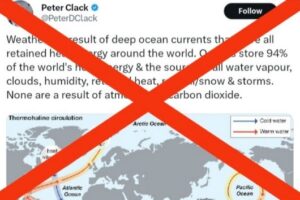Physical Address
23,24,25 & 26, 2nd Floor, Software Technology Park India, Opp: Garware Stadium,MIDC, Chikalthana, Aurangabad, Maharashtra – 431001 India
Physical Address
23,24,25 & 26, 2nd Floor, Software Technology Park India, Opp: Garware Stadium,MIDC, Chikalthana, Aurangabad, Maharashtra – 431001 India

Claim: Weather results from deep ocean currents that drive all retained heat/energy worldwide. Oceans store 94% of the world’s heat/energy & the source of all water vapour, clouds, humidity, retained heat, rainfall/snow & storms. None are a result of atmospheric carbon dioxide.
Fact: False. While oceans store most of the Earth’s retained heat and drive weather systems, atmospheric CO₂ is a crucial contributor to global warming. It influences weather by trapping heat, warming oceans, and intensifying storms, rainfall, and other phenomena.
X post:
What does the post say
Peter Clack, a known sceptic of climate science, made a bold assertion on X that deep ocean currents alone drive weather systems, while atmospheric CO₂ plays no role. His claim disregards well-established scientific findings that highlight the interconnected nature of oceanic and atmospheric systems.
This narrative aligns with a broader trend of misinformation aimed at downplaying the role of greenhouse gases, particularly CO₂, in climate change. It is essential to address such claims to reaffirm the scientific consensus on the combined roles of atmospheric and oceanic processes in influencing Earth’s weather and climate.
What we found
Peter Clack’s statement is scientifically inaccurate. Weather systems result from intricate interactions between the atmosphere and the oceans, with atmospheric CO₂ playing a pivotal role. While the oceans store and redistribute most of Earth’s heat, this process is intrinsically tied to atmospheric conditions, which heavily influence CO₂ and other greenhouse gases. Ignoring these interactions oversimplifies the climate system and misrepresents the science behind global warming and its effects on weather patterns.
The Role of Oceans in Driving Weather
Oceans serve as Earth’s primary heat reservoir, absorbing nearly 94% of the excess heat generated by human-induced global warming. This stored heat drives key weather patterns through ocean currents and evaporation processes.
Deep ocean currents, such as the thermohaline circulation, redistribute heat globally. In contrast, surface currents like the Gulf Stream and climate phenomena like El Niño and La Niña significantly impact regional weather patterns. For instance, El Niño events can bring heavy rainfall to some regions while triggering droughts in others.
Furthermore, oceans are the primary source of water vapour, which drives cloud formation and precipitation. However, the warming of the oceans, and thus their ability to influence weather, is closely linked to atmospheric heat. This heat, in turn, is primarily retained by greenhouse gases, with CO₂ playing a dominant role.
How Atmospheric CO₂ Shapes Weather
Atmospheric CO₂ is not just a passive component; it actively contributes to weather and climate dynamics in multiple ways:
By trapping heat, CO₂-driven warming raises sea surface temperatures, energising storms. Warmer waters fuel hurricanes and cyclones, intensifying their strength and impact. Events like Hurricane Harvey and Cyclone Amphan highlight how elevated ocean temperatures, influenced by atmospheric warming, amplify weather extremes.
Higher CO₂ levels increase the atmosphere’s capacity to hold water vapour, leading to heavier rainfall in some regions and prolonged droughts in others. These shifts in precipitation patterns disrupt ecosystems and human livelihoods, particularly in areas dependent on predictable weather for agriculture.
Melting polar ice, driven by CO₂-induced warming, reduces Earth’s reflectivity, causing oceans to absorb even more heat. This creates a feedback loop: warmer oceans release additional water vapour, intensifying global warming and its weather-related consequences.
Phenomena Highlighting CO₂’s Influence
Conclusion
The claim that atmospheric CO₂ plays no role in weather phenomena is factually incorrect. While it is true that oceans store and distribute a large portion of Earth’s heat, they operate in tandem with atmospheric processes. Atmospheric CO₂ significantly influences ocean temperatures and weather patterns, driving more intense storms, shifting rainfall distributions, and triggering feedback loops exacerbating global warming.
Dismissing the role of CO₂ oversimplifies Earth’s complex climate system and undermines decades of peer-reviewed research. Recognising the interconnected roles of oceans and atmospheric greenhouse gases is crucial for understanding and addressing the impacts of climate change on weather systems.
References:
https://oceanservice.noaa.gov/education/tutorial_currents/05conveyor1.html
https://www.climate.gov/news-features/understanding-climate/climate-change-ocean-heat-content
https://www.sciencedirect.com/science/article/pii/S2225603223000437
https://oceanservice.noaa.gov/facts/sea-ice-climate.html
https://www.epa.gov/climatechange-science/basics-climate-change
Comments are closed.
I am glad to be one of many visitants on this outstanding internet site (:, thanks for posting.